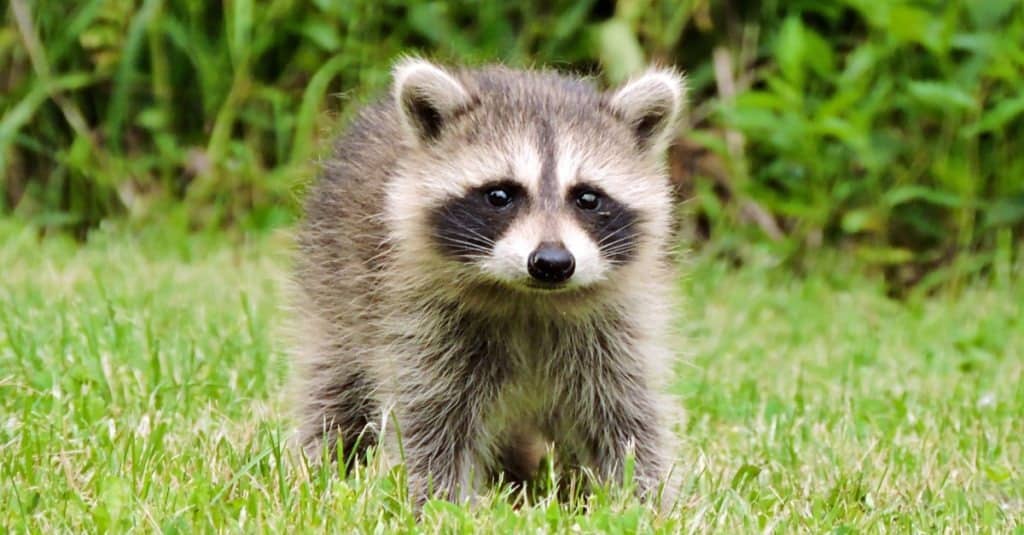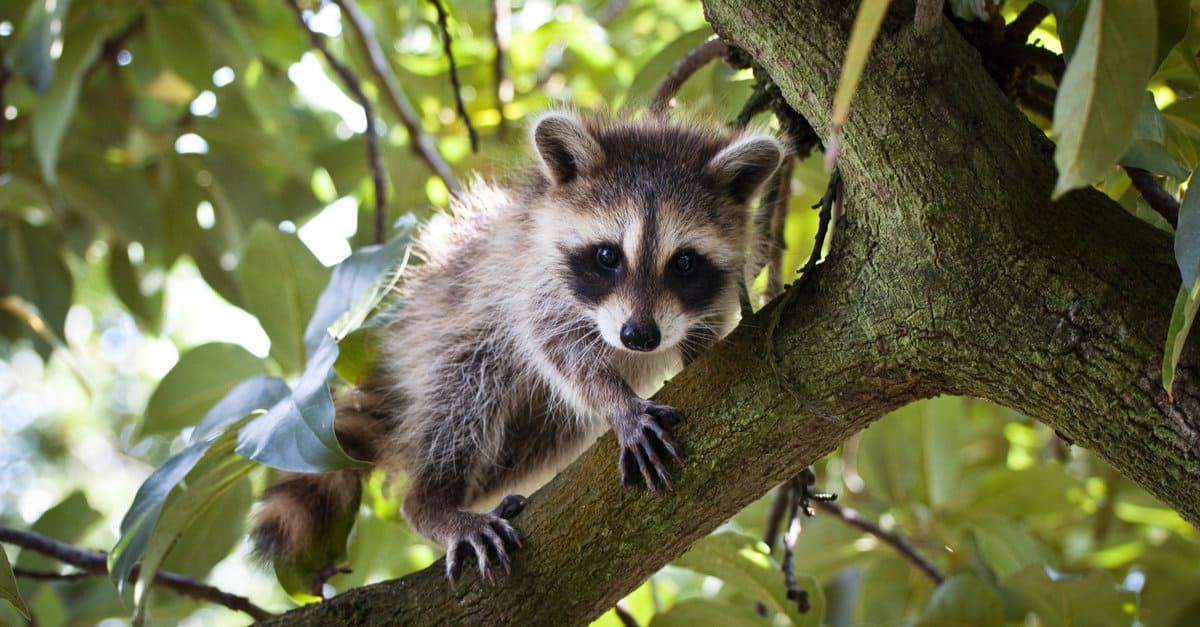Baby trash pandas are undoubtedly some of the cutest offspring in the animal kingdom. It can be quite an adventure if you come across one while hiking. In this article, you’ll learn how to care for a baby raccoon and the steps needed.
Please remember that as cute as a baby raccoon can be, they are still wild animals and should be treated with respect. Even as a baby, they can still create damage with their claws, chew up household items, and bite.

Please remember that as cute as a baby raccoon can be, they are still wild animals and should be treated with respect.
©sinagrafie/Shutterstock.com
How to Tell If a Baby Racoon is Wandering or Orphaned
Just like human kids, a baby raccoon is likely to wander away from mom. However, if the baby raccoon has been walking around for more than a few hours, the baby is likely abandoned.
You can also place a laundry basket upside down with the baby under it. Then, you can leave them under it until nightfall. Since raccoons are nocturnal creatures, mama raccoon will come back to obtain her baby. If you return that night and find the baby is still there, then you have an orphaned raccoon on your hands.

Just like human kids, a baby raccoon is likely to wander away from mom.
©Georgi Baird/Shutterstock.com
8 Steps to Care for a Baby Raccoon
Below are 8 easy steps to provide adequate care for a baby raccoon until help arrives.
1. Determine If the Baby Racoon is Abandoned or Wandering
Following the above information, your first step will be determining if the baby raccoon has wandered away from mom or has been orphaned. Once you have determined the status of the baby raccoon, you will need to find a safe place for the baby.
2. Get the Baby Racoon to Safety
A baby raccoon that has been abandoned cannot fend for itself. Therefore, you must take it with you.
If you aren’t sure about what to keep a baby raccoon in, you can use supplies like cat or dog crates to keep them safe and transport them. Once you have brought them to your house, you can keep them in a spare room until help arrives.
Moreover, you need to pay special attention to where the baby is. If the raccoon is in the forest, be certain to be aware of predators that are on the prowl.
3. Keep Them Warm
As babies, raccoons need all the warmth they can get. Keep in mind that most raccoons have a normal temperature that is around 101 degrees. The easiest way to keep a baby raccoon warm is to fill a water bottle with warm water and store it in the box with them.
4. Don’t Use Hot Water
You may think that the hotter the water, the better it will be for the raccoon. On the contrary, water that is too hot can kill a raccoon. You can either check to ensure the water bottle does not get hot, or you can use a heating pad in the crate with them.
5. Call Your Local Wildlife Rescue
As tempting as it may be to keep the raccoon, do not. Caring for a baby raccoon can be extremely challenging and should be left to the professionals. If you have trouble finding a rescue, you can consult your veterinarian for recommendations.
6. Don’t Feed the Baby Raccoon Before Hydrating
It is human nature to want to cuddle, feed, and nurture abandoned animals. Yet, when it comes to raccoons, it is bad for their digestive tract to feed them without properly hydrating them first. Thankfully, a baby raccoon can be hydrated by feeding it with a baby bottle, nipple, and Pedialyte. Allow the baby to drink 1-3 times every hour.
If you do not have Pedialyte, you can make your own by mixing 1 point of purified water, 1 teaspoon of sugar, and ⅓ teaspoon of salt.
7. Follow a Feeding Schedule
Whether you are keeping the raccoon, or preparing it for the rehabilitationist, you will need to feed it. Simply mix 2 ¼ parts of water with 1 part kitten formula. Do not feed a baby raccoon dairy milk, or puppy milk. Any milk other than kitten milk can harm their sensitive stomachs.
You may wish to ask the wildlife rescue how much you should feed the raccoon.
8. Do Your Research
If you can’t find a local rehabilitationist, it may be tempting to keep the raccoon. If you must keep it for whatever reason, please remember to do the research to provide adequate care.
Similarly, you must keep in mind finances, time, and commitment. Raccoons are not low maintenance and require proper handling and training. This helps to ensure that they are raised properly in a domesticated environment.
You must also check to make sure it is legal to keep a raccoon in your state. Consequently, keeping a raccoon illegally can have serious consequences such as fines, and jail time.

If you must keep the baby raccoon for whatever reason, please remember to do the research to provide adequate care.
©Jenna Bettinger/Shutterstock.com
Recap: How to Care for a Raccoon
In conclusion, encountering a baby raccoon can be quite an adventure. What’s more, is that these 8 steps will teach you how to care for a baby raccoon until help arrives.
| Step | Directions |
| 1. Determine the Status | Observe if the baby raccoon has been alone for more than a few hours. If it has, this means that the raccoon has been dumped by the mother. |
| 2. Get Baby Raccoon to Safety | Carefully get the raccoon into a safe crate, and bring it to a spare room in the house. DO NOT let children, adults, or pets play with it. |
| 3. Keep Warm | Place a warm water bottle, or heating pad on low settings inside the crate with the baby raccoon to keep them from freezing. |
| 4. Don’t Use Hot Water | Hot water is too warm for a raccoon and can kill them. Only use a warm water bottle, or heating pad on low settings. |
| 5. Contact Help | Call your local rehabilitationist, or veterinary professional to get the raccoon to the right place. |
| 6. Hydrate | Before feeding the raccoon, provide it with adequate hydration. |
| 7. Feed the Trash Panda | Depending on how old the baby is, you will need to feed it. Again, do NOT feed the raccoon until they have received proper hydration first. |
| 8. Do Your Research | If you must keep the raccoon, please make sure you research the proper care for it. |
Thank you for reading! Have some feedback for us? Contact the AZ Animals editorial team.








